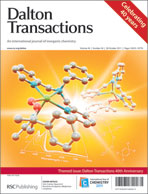Issue 40 of the 40th volume of Dalton Transactions has now been published online!
40th Birthday Issue of Dalton Transactions now online!
The latest issue of Dalton Transactions celebrates 40 years of publishing high-impact inorganic chemistry
Hot Article: Organoruthenium anti-cancer complexes
![The organometallic anticancer complex [(η6-p-cymene)Ru(en)Cl]PF6](http://pubs.rsc.org/services/images/RSCpubs.ePlatform.Service.FreeContent.ImageService.svc/ImageService/image/GA?id=C1DT11189B)
In this Dalton Transactions Hot article the team investigate how the complex interacts with the active site of PTP1B by using a similiar shaped molecule as a model. Their compound was found to have an IC50 of 19 μM.
Read the full article for FREE until 2nd November to find out more about how this anticancer compound works…
Reactions of an organoruthenium anticancer complex with 2-mercaptobenzanilide—a model for the active-site cysteine of protein tyrosine phosphatase 1B
Yumiao Han, Qun Luo, Xiang Hao, Xianchan Li, Fuyi Wang, Wenbing Hu, Kui Wu, Shuang Lü and Peter J. Sadler
Dalton Trans., 2011, DOI: 10.1039/C1DT11189B
Keep up to date with the latest news and research in inorganic chemistry: sign up to the Dalton Transactions e-alert, check out our blog, and follow us on Twitter.
Perspective: Suning Wang on triarylboron compounds for optoelectronics

Wang and her PhD student, Zachary Hudson, discuss the role of boron, and the photophysical properties of metal-containing triarylboranes. They go on to review the recent research, looking at triarylboron-containing complexes in OLEDs and as anion sensors, as well their use in MOFs, zinc sensors and as vapochromic materials to detect VOCs.
Read the full article to find out more…
Metal-containing triarylboron compounds for optoelectronic applications
Zachary M. Hudson and Suning Wang
Dalton Trans., 2011, 40, 7805-7816
DOI: 10.1039/C1DT10292C
Professor Wang is an Associate Editor for our new journal, RSC Advances, read more about her research.
Unusual structure is ‘silver’ lining in Ag study
 A team of scientists from Poland have been playing around with silver-pyrazine complexes and made an unusual crystal structure of a Ag(I) by–product in the process. Piotr J. Leszczyński, Wojciech Grochala and colleagues from Warsaw studied the decomposition of di(pyrazine)silver(II) peroxydisulfate under various heat and chemical processes.
A team of scientists from Poland have been playing around with silver-pyrazine complexes and made an unusual crystal structure of a Ag(I) by–product in the process. Piotr J. Leszczyński, Wojciech Grochala and colleagues from Warsaw studied the decomposition of di(pyrazine)silver(II) peroxydisulfate under various heat and chemical processes.
Much work has been carried out on the copper analogue before this but only now is the silver version really being looked at. Read more in this recent Hot Article – FREE to read until the end of October:
.
.
Thermal and chemical decomposition of di(pyrazine)silver(II) peroxydisulfate and unusual crystal structure of a Ag(I) by-product
Piotr J. Leszczyński, Armand Budzianowski, Łukasz Dobrzycki, Michał K. Cyrański, Mariana Derzsi and Wojciech Grochala
Dalton Trans., 2011, DOI: 10.1039/C1DT10744E 
Call for papers: Themed issue – Application of inorganic chemistry for non-cancer therapeutics
Find how you can submit to Dalton Transactions upcoming themed issue on the application of inorganic chemistry for non-cancer therapeutics, guest edited by Kathy Franz…
We are pleased to announce an upcoming themed issue on the topic of the application of inorganic chemistry for non-cancer therapeutics, guest edited by Kathy Franz. It is our pleasure to invite you to contribute to this themed issue.
In this issue we seek to showcase the many ways in which principles of inorganic chemistry can be applied to tackle challenges in human health and disease. Recent themed issues of Dalton Transactions have explicitly covered metal anticancer compounds (2009) and radiopharmaceuticals (2011). This themed issue will emphasize other arenas where the creativity of inorganic chemists can contribute to the development of novel therapeutic agents.
How to submit?
All types of manuscript, Communications, Full Papers and Perspectives, will be considered for publication. We aim to publish this themed issue in 2012 and therefore would like to receive manuscripts by 15th November 2011. The manuscript should be prepared according to the format for regular articles and should be submitted via our online system. All invited manuscripts will be subjected to the normal refereeing procedure.
Deadline for Submission: 15th November 2011
Please indicate on submission that your manuscript is intended for this themed issue and direct any questions to theDalton Transactions Editorial Office.
We invite you to also check out previous themed issues featuring in Dalton Transactions. Read them here now.
Inorganic Conference of the Royal Australian Chemical Institute and the New Zealand Institute of Chemistry
Dalton Transactions is delighted to be sponsoring the 2011 Inorganic Conference of the Royal Australian Chemical Institute and the New Zealand Institute of Chemistry in Perth in December.
The meeting promises to be a great event, with plenary speakers such as Neil Champness, Munetaka Akita and Luisa De Cola. Find out more about who else is speaking: http://www.ic11.org.au/node/13
Early bird registration has been extended to 1st October 2011, so there is still time to sign up!
HOT Article: Accidentally on purpose, a relatively simple model to study magneto-structural relationships in complex Mn clusters

Read more for FREE until 21st September at:
Ross Inglis, Edel Houton, Junjie Liu, Alessandro Prescimone, Joan Cano, Stergios Piligkos, Stephen Hill, Leigh F. Jones and Euan K. Brechin
Dalton Trans., 2011, Advance Article
DOI: 10.1039/C1DT11118C
HOT Article: Coordination scales

Read more for FREE until 11th October about this elegant solution:
Coordinating ability of anions and solvents towards transition metals and lanthanides
Raúl Díaz-Torres and Santiago Alvarez
Dalton Trans., 2011, Advance Article
DOI: 10.1039/C1DT11000D
HOT Article: 1-borabenzonitrile

Read more for FREE until the 4th October at:
1-Borabenzonitrile (B-cyanoboratabenzene)
Ian A. Cade and Anthony F. Hill
Dalton Trans., 2011, Advance Article
DOI: 10.1039/C1DT10849B
Top ten most accessed articles in August
This month sees the following articles in Dalton Transactions that are in the top ten most accessed:-
New star-shaped trinuclear Ru(ii) polypyridine complexes of imidazo[4,5-f][1,10]phenanthroline derivatives: syntheses, characterization, photophysical and electrochemical properties
N. Arockia Samy and V. Alexander
Dalton Trans., 2011, 40, 8630-8642 DOI: 10.1039/C1DT10811E
Non-steroidal antiinflammatory drug–copper(II) complexes: Structure and biological perspectives
Filitsa Dimiza, Stella Fountoulaki, Athanasios N. Papadopoulos, Christos A. Kontogiorgis, Vassilis Tangoulis, Catherine P. Raptopoulou, Vassilis Psycharis, Aris Terzis, Dimitris P. Kessissoglou and George Psomas
Dalton Trans., 2011, 40, 8555-8568 DOI: 10.1039/C1DT10714C
New nickel(ii) and iron(ii) helicates and tetrahedra derived from expanded quaterpyridines
Christopher R. K. Glasson, George V. Meehan, Cherie A. Motti, Jack K. Clegg, Peter Turner, Paul Jensen and Leonard F. Lindoy
Dalton Trans., 2011, Advance Article DOI: 10.1039/C1DT10667H
Reactivity of copper(ii)-alkylperoxo complexes
Tetsuro Tano, Mehmed Z. Ertem, Satoru Yamaguchi, Atsushi Kunishita, Hideki Sugimoto, Nobutaka Fujieda, Takashi Ogura, Christopher J. Cramer and Shinobu Itoh
Dalton Trans., 2011, Advance Article DOI: 10.1039/C1DT10656B
Nickel complexes of a bis(benzimidazolin-2-ylidene)pyridine pincer ligand with four- and five-coordinate geometries
David H. Brown and Brian W. Skelton
Dalton Trans., 2011, 40, 8849-8858 DOI: 10.1039/C1DT10928F
The coordination chemistry of Zn(ii), Cd(ii) and Hg(ii) complexes with 1,2,4-triazole derivatives
Ke Liu, Wei Shi and Peng Cheng
Dalton Trans., 2011, 40, 8475-8490 DOI: 10.1039/C0DT01578D
Binuclear half-metallocene chromium(iii) complexes mediated ethylene polymerization with alkylaluminium as cocatalyst
Tieqi Xu, Yu Pan and Xiao-Bing Lu
Dalton Trans., 2011, 40, 8643-8650 DOI: 10.1039/C1DT10803D
Reduction of copper(ii) complexes of tridentate ligands by nitric oxide and fluorescent detection of NO in methanol and water media
Pankaj Kumar, Apurba Kalita and Biplab Mondal
Dalton Trans., 2011, 40, 8656-8663 DOI: 10.1039/C1DT10773A
Spin crossover and polymorphism in a family of 1,2-bis(4-pyridyl)ethene-bridged binuclear iron(ii) complexes. A key role of structural distortions
Galina S. Matouzenko, Erwann Jeanneau, Alexander Yu. Verat and Azzedine Bousseksou
Dalton Trans., 2011, 40, 9608-9618 DOI: 10.1039/C1DT10312A
Cleavage of unreactive bonds with pincer metal complexes
Martin Albrecht and Monika M. Lindner
Dalton Trans., 2011, 40, 8733-8744 DOI: 10.1039/C1DT10339C
Why not take a look at the articles today and blog your thoughts and comments below.
Fancy submitting an article to Dalton Transactions? Then why not submit to us today or alternatively email us your suggestions.













